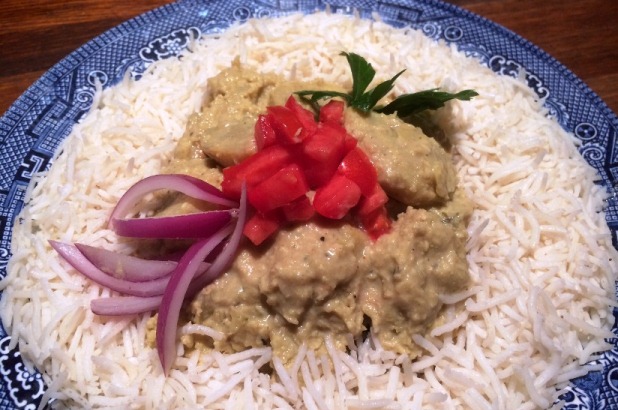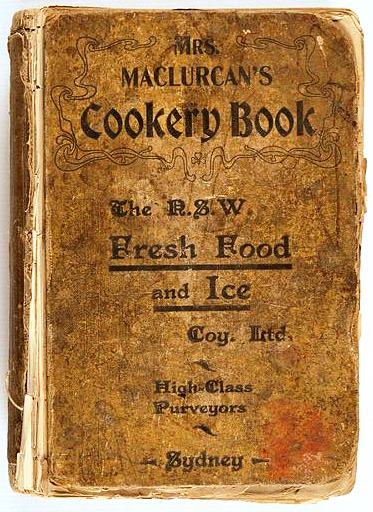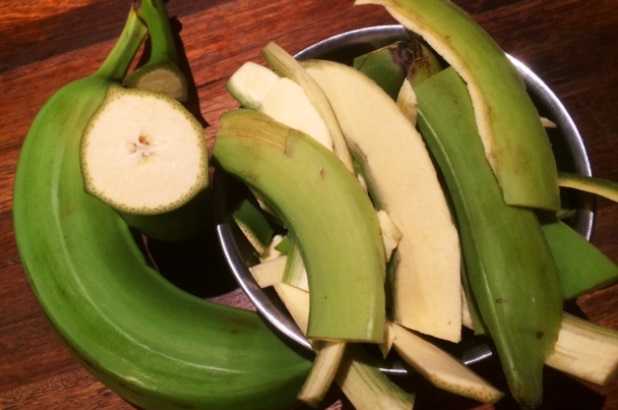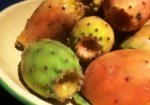The Curator’s story about bananas and plantains earlier this year recalled the banana curry I enjoyed at Hannah’s Long Lunch last year, which celebrated colonial cookery author, Hannah Maclurcan. I’ve now put Mrs Maclurcan’s recipe for ‘banana curry’ to the test using green plantains, with pleasing and thought provoking results.
Curried Bananas
6 green bananas; 1/2 a cupful of dessicated cocoanut; 1/2 a pint of milk [285ml]; 2 tablespoonsful of curry powder; a little cayenne and salt; 1 teasponnful of Worcestershire sauce; 1 teaspoonful of anchovy sauce; 1 egg
MODE: Put in a basin the cocoanut, and pour over it the milk, and allow it to stand one hour; then put it into a saucepan with the other ingredients. Peel and slice the bananas and add to the curry;
allow it to simmer for ten to fifteen minutes, and just before serving beat up the egg and stir it in; serve with boiled rice.
Mrs Maclurcan’s cookery book, first published 1898
(A modern conversion is given below)
Mrs Maclurcan’s cookery book
As proprietor of The Wentworth Hotel near Wynyard Square in Sydney, which had a notable dining room, Hannah Maclurcan was something of a celebrity in the early 1900s. A third edition, c1903 of Mrs Maclurcan’s cookery book, belonging to Nina Terry (nee Rouse) remains in the Rouse Hill House and Farm collection. Its relative state of disrepair stands testament to how well it was used, in Nina’s home at Box Hill, and later at Rouse Hill House when she returned to live there with her family in the 1920s. Despite having had a dedicated cook on the staff for most of her life, Nina took on the cooking duties for the busy household.
Nina Terry’s Mrs Maclurcan’s cookery book c1903. Rouse Hill House and Farm Collection © Sydney Living Museums
Tropical Tastes
Many of the recipes in the book recall Maclurcan’s early career in catering in hotels her father owned in Queensland, using exotic ingredients such as prickly pears, granadillas – a variety of passionfruit, and green bananas. She gives two recipes for green bananas, one being the curry and the other, the other, a less spicy option for simmered bananas served on toast with a white sauce. My father enjoyed leeks cooked the same way, as a Sunday night supper after the obligatory roast meat lunch, but I digress… I have one plantain left over (they were huge!) so this may be its destiny:
Green Bananas as a Vegetable
6 bananas; 1/2 a pint of milk; 1 tablespoonful of butter; 1 teaspoonful of salt; 1/2 a teaspoonful of pepper.
MODE: Peel and cut the bananas in two, place in a saucepan with the milk, salt and pepper, and simmer gently for half an hour; then thicken with flour and add the butter; serve up with toast.
The bananas can be boiled in water and white sauce poured over them.
Green banana plantains Photo © Jacqui Newling for Sydney Living Museums
Food for thought
A few things struck me as I made the Curried Bananas:
– Soaking desiccated coconut in milk is what we used to do before imported tins of coconut milk became easily obtainable in supermarkets. Sophisticated recipes would then have you rub the mixture through a sieve and discard the chewy solids, which always seemed terribly wasteful. While I’m not a great fan of desiccated coconut even in desserts, the texture of the coconut in this curry was an interesting contrast to the chewy density of the plantain, and not nearly as cloyingly sweet as canned coconut milk.
– The skins of the plantains cling to the edible flesh within the fruit, and need to be peeled with a knife. The flesh is particularly dense and chewy, and not at all banana-ly sweet. The seeds start to brown once exposed to the air, so wait until your sauce is ready before slicing the fruit.
– The addition of Worcestershire and anchovy sauces was interesting. With the addition of an egg to enrich the sauce, the ingredients on open glance conjure bananas in a coconut Ceasar Salad sauce. Be sure not to add the egg into the sauce until ready to serve, or it will cook and curdle.
– Pantry staples in Mrs Maclurcan’s day the salty sauces complemented the ubiquitious Madras style curry powder, adding a welcome depth of flavour. The Worcester was a little obvious for my taste, but necessary for its savouriness and slight vinegary acidity. Anchovy sauce, now rarely used, is richer and a bit more aggressive than Asian fish sauce, perhaps closer to ‘blachan’ or Asian shrimp paste which is popular in Malaysian and Thai dishes. You could easily substitute with these, or mash up an anchovy to add to the sauce to maintain the ‘authentic’ intended taste of the curry.
The taste test
My mother, who lived in India in the 1950s, invariably served banana slices tossed in coconut as an accompaniment to a hot curry. Mum would squeeze a lime over the bananas to prevent them from discolouring, and sometimes added sultanas, which gave the dish a sweet-sour tang and pleasant mix of textures. This curry would be much improved with a good squeeze of lime to add tang, and perhaps even tamarind or a handful of currants to give a tart-sweet edge. Fresh tomato, onion and parsley (coriander or mint would work well too) used for garnish gave it some freshness and a hot mango pickle served along side worked a treat. But yes, the curry was well worth making and we’d be happy to eat it again.
Curried bananas
Ingredients
- 1/2 cup desiccated coconut
- 1/2 cup milk
- 2 tablespoons curry powder, or to taste
- pinch cayenne pepper (or chilli powder), or to taste
- 1 teaspoon anchovy sauce (or substitute fish sauce)
- 1 teaspoon worcestershire sauce
- 2 large or 6 small green or very unripe bananas
- 1 egg, beaten to finish the sauce
- boiled rice, to serve
Note
This recipe is taken from Nina Terry's (nee Rouse) copy of Mrs Maclurcan's cookery book, c1903, now held in the Rouse Hill House & Farm collection. If the bananas are very large, use only two or three. You can use store-bought coconut milk instead of the desiccated coconut soaked in milk.
Directions
| Put the desiccated coconut into a bowl with the milk and allow it to stand for an hour. Transfer the mixture to a large saucepan and stir in the curry powder, cayenne pepper, and anchovy and worcestershire sauces. Bring to a gentle simmer, adding a little water or milk if the sauce is too thick. Peel and slice the bananas and add to the curry sauce. Check the seasoning and adjust to taste. Simmer for 15 minutes. Just before serving, gently stir in the beaten egg. Serve immediately with boiled rice. | |
| Cook's tip: for a dairy-free version, use commercial coconut milk instead of regular milk, or use thick coconut cream and omit the milk and egg. | |



 Print recipe
Print recipe

